March 11, 2015
So many advancements occur in plastic packaging that it's no surprise that the DuPont awards turned out a total of 15 winners, offering every convenience and/or added value imaginable, as well as new materials and visuals that pop off the shelf as a result of stylish graphic designs, and printing and converting talent. New and emerging technologies, machinery and innovative material manipulation combine with molding, forming and other converting developments, along with marketing strategies to produce packaging with increased sales appeal, performance and economies.
Thirteen international food and nonfood packaging innovations, generated from 51 submissions, were honored with 16 awards for innovation in food processing and packaging. All recognize advancements that incorporate plastic packaging materials in the food segment and the nonfood group. Voted most innovative, two of the winners this year received the Diamond Award for the most significant contributions out of all of the packaging developments presented below.
The competition is sponsored by DuPont in cooperation with Campden & Chorelywood Food Research Association in Gloucestershire, England, and the National Food Processors Association in Washington, DC.
Retortable carton for Friskies
It's ironic that the first of the Diamond award winners went to what looks like an all-paperboard carton, but Tetra Pak's Recarte package (1) 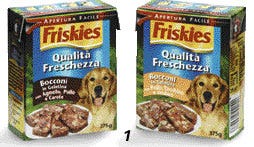 employs a construction incorporating proprietary plastic polymers that allow the new package to be retorted. Adopted for "wet," shelf-stable dog food by Nestlé Pet Food Italy for the Friskiesw brand, the unique carton is a collaboration between Nestlé, Tetra Pak AB, Sweden and Tetra Pak U.S.
employs a construction incorporating proprietary plastic polymers that allow the new package to be retorted. Adopted for "wet," shelf-stable dog food by Nestlé Pet Food Italy for the Friskiesw brand, the unique carton is a collaboration between Nestlé, Tetra Pak AB, Sweden and Tetra Pak U.S.
The material rolls many benefits into one laminate. Long considered next to impossible, developing a carton that can hold its own under the rigors of a low-acid process took Tetra Pak many years of testing polymers and other materials before reaching an acceptable result. A key component in the package is a highly moisture-resistant fiberboard material and the proprietary polymers that support the structure during retorting at conventional retort temperatures (up to 262 deg F for up to two hours), while the foil and polymers provide barrier properties. The lacquer-coated and printed fiberboard on foil creates a glossy, smooth surface and an eye-catching package, while the print surface resists scratching.
Graphics are printed on the fiberboard using a four-color photoprocess-printing method, described as an advanced flexo process, using proprietary, heat-resistant inks. Product copy is printed in either English, French, Japanese or Italian, depending on the specific distribution channel. Five stockkeeping units of dog food in the 375-g pack size are being marketed in Europe and Japan under either the Friskies or Alpo brands.
Nestlé Purina Petcare Europe, the lead field test customer, began marketing dog foods in the new carton in Italy in May, '01, and also rolled it out to France, the U.K., Switzerland and Japan in September, '01. This marked Recart's commercial debut.
Also winning a gold award in the food category, the carton measures nearly 41/4 in. tall, 31/4 in. wide and 13/4 in. deep. A wide opening facilitates pouring of its chunky contents. Space- and cube-efficient, lightweight and easy-to-stack, the package looks similar to other cartons, but the carton stock is produced differently, according to Tetra Pak, so it can withstand retorting. Exactly how this is done is proprietary, but Tetra Pak says that steam-air retorts are used, and the firm is also evaluating the use of other conventional retort technologies.
Designed for vegetables, soups, ready-to-eat meals, fruit and other foods traditionally packed in metal cans or glass jars, the carton has an easy-to-use, laser-perforated opening device that can be activated after flaps on either side of the top seal are pulled up to reveal a tearstrip.
Tetra Pak's Steve Hellenschmidt, general manager of prepared foods, says studies conducted both by Tetra Pak and external sources indicate that the carton shows positive results both in pure hot-fill processes as well as in hot-fill-and-hold, water-spray pasteurization tunnels. "We believe this process offers producers of high-acid products, such as tomatoes or salsa, an opportunity to utilize the benefits of Tetra Recart with a significantly lowered capital investment. We will continue to evaluate this in the near future," he says.
Produced at speeds up to 400 packages/min on Tetra Pak's Tetra Recart™ form-and-seal machine, the new carton is designed to provide food manufacturers with an alternative to metal cans and glass, without any sharp edges. The Recart system accepts premade carton blanks on an infeed and erects the blanks by inserting them into a carrier that holds them in place until the final folding stage, after which the package is ready for retorting.
The carton top is then sealed, and the carton is sent, upside-down, to an external filling machine. Upon returning to the Recart system, the carton has its bottom sealed, and the package is fully formed. The system incorporates a continuous induction sealing method.
Nestlé's Alessandro Zanelli of the Nestlé Purina Petcare's European marketing group in the U.K. says that field test reports indicate that so far the new pet food, chunks of meat in a gelatin, is seeing market-share popularity. Consumers and retailers alike favored the new packaging format. "The package is a real breakthrough in the pet food market," he says. "With premium market positioning, the new package is considered superior to a can and significantly more convenient. The pack offers convenience, freshness, quality and an appetizing appearance, and it can be priced in-line with the Pedigree brand."
PD learns that the Tetra Pak machine was installed on a new Nestlé production line. Shelf stability is product-dependent, but Hellenschmidt indicates that the shelf-life goal for most products is 24 months. Current date coding on the Friskies/Alpo products is posted at 18 months. The package is also said to cost about the same as a metal food can.
Tetra Pak says that due their space-efficient shape, three cartons can be placed in the same shelf space as two metal cans. And, a truckload of blanks contains the same amount of packaging as about 16 truckloads of similarly sized empty cans. Not only can the carton replace metal food cans and glass jars, but it can also substitute for standup pouches.
Many years of research and development went into the creation of Recart, notes Hellenschmidt, who adds that Tetra Pak evaluated hundreds of laminate variants before the correct marriage of materials was discovered. "We're very excited about this development," he continues. "We have had very positive feedback from several major U.S. brands and plan to commercially launch products in the Recart carton system in the U.S. in the fall of '03, with a focus on human food applications. It's going to be a pretty interesting time for us." Circle No. 327.
Secret's in the lid
The second Diamond award went to an oxygen-scavenger lidding film developed by Cryovac Div. of Sealed Air and used by Nestle's Buitoni® fresh, refrigerated pasta (2). 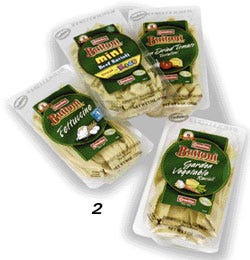 Topping semi-rigid, thermoformed trays of refrigerated pasta packed under modified atmosphere, OS Film lidding can reduce the amount of oxygen inside the trays, increasing shelf life of the Buitoni products by as much as 50 percent, Nestlé confirms.
Topping semi-rigid, thermoformed trays of refrigerated pasta packed under modified atmosphere, OS Film lidding can reduce the amount of oxygen inside the trays, increasing shelf life of the Buitoni products by as much as 50 percent, Nestlé confirms.
Replacing a conventional barrier film lamination in Nestlé's case, the OS Film's invisible oxygen-scavenging technology is a first-of-its-kind for such a product, PD is told.
Nestlé began using the patented film lidding for Buitoni in May, '01 to help reduce product spoilage and increase the shelf life of pastas in 7-, 9- and 20-oz tray sizes.
Cryovac says the Nestlé Buitoni package structure is the same as when PD recently reported on it, when it won an award in the Flexible Packaging Association's competition (see PD, March, '02, p. 32). The Buitoni package's film lidding is a 3.5-mil lamination heat-sealed to a semi-rigid, thermoformed, multilayer-film base tray with a multilayer, coextruded scavenging-film-compatible polyethylene sealant. The oxygen scavenger is incorporated into the film as a proprietary polymer, coextruded into a discrete film layer and adhesively laminated to a proprietary coextruded polyethylene terephthalate (polyester) substrate, coated with a polyvinylidene chloride barrier layer, DuPont's Saranw. The multiple sealant layers provide excellent sealability and help optimize the film's oxygen-scavenging capabilities.
Unlike traditional iron-based oxygen-scavenging materials, the flexible film incorporates patented "triggering" chemistries and processes. Once triggered, the film will continue to scavenge oxygen independently of the product or environment in which it is used. The film can offer processors and retailers more time to move and distribute perishable products and opens up a new category of active packaging.
OS Film is significant for removing residual oxygen from the package, achieving oxygen levels of less than 0.1 percent in three to eight days. Cryovac points out that the reduced oxygen levels are dependent upon having an initial oxygen concentration of typically less than 2 percent inside the package, which means the product must be packed under modified atmosphere conditions. So while the lidding alone can't substitute for gas flushing, it could allow a processor to start with a higher oxygen concentration, Cryovac tells PD. In most applications, however, it cannot drive the oxygen concentration down to those levels starting at atmospheric oxygen.
Integral with the film, the scavenger cannot be seen with the naked eye. It's activated on-demand, through a patented process, by Cryovac's Series 4100 ultraviolet light-triggering system. Nestlé installed a bank of such light-triggering units on an existing horizontal thermoform/fill/seal line at its Buitoni pasta packaging facility in Danville, VA, where rolls of the lidding are shipped and the pastas are packaged. As the UV light from the 4100 system shines through the film and reaches the special polymer, the oxygen scavenger is activated just prior to filling and sealing.
Nestlé marketing director Brian Nau tells PD that the packaging has been very successful. "In terms of growing distribution, it allows us to reduce costs by having a longer shelf life in the marketplace. We're very pleased with it and, in terms of market performance, the brand continues to grow market share. It has sixty-plus percent of the refrigerated pasta-and-sauce market now, up about three points versus a year ago. The packaging has definitely played a role in that performance."
The Nestlé application is just one way the film can be produced, as Cryovac offers a series of film formats. But in order for products to gain the additional oxygen protection that the OS Film affords, the film must actually scavenge oxygen and thus be triggered properly. And, because the film is transparent and scavenging is invisible, it can be difficult for users to know if the film has been activated and is scavenging. So Cryovac has developed a "fast" scavenging-verification system that allows OS Film customers to perform QA tests on the film to ensure it's doing its job. Instead of waiting eight hours, for example, before a meaningful drop in the oxygen concentration can be measured, the fast QA system can determine if film is scavenging oxygen in less than three hours.
Controlling oxidative color changes, rancidity, microbial growth, and protection of sensitive food ingredients and nutrients will no doubt benefit many food products. The technology is also applicable to rigid and flexible packaging applications with snack foods, juices, processed meat and cheese, nuts, dried vegetables and fruits. Cryovac says it is working with a number of packagers that are evaluating the material for everything from modified-atmosphere applications to vacuum-packaged sliced lunch meats, ham, franks, sausages and cooked meats. Circle No. 328.
Thermoform facilitates feedings
With so many working parents these days, a portable, break-resistant and resealable baby food package is just what the doctor ordered. Gerber Products delivers, with a wide-mouth, aseptic thermoformed package (3) 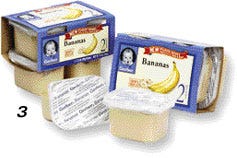 for its 2nd Foods Recipes that represents a new design and technical innovation for baby food packaging (also see PD, August, '01, p. 2). Winning a gold award in the food category for Gerber Products Company/Novartis Consumer Health and Hassia U.S. and Germany, the 3.5-oz package is the first plastic container for baby food available nationally in the U.S.
for its 2nd Foods Recipes that represents a new design and technical innovation for baby food packaging (also see PD, August, '01, p. 2). Winning a gold award in the food category for Gerber Products Company/Novartis Consumer Health and Hassia U.S. and Germany, the 3.5-oz package is the first plastic container for baby food available nationally in the U.S.
Containing product varieties in Applesauce, Bananas, Peaches and Pears–Gerber's most popular pureed fruits–the containers were introduced in February, '01, sleekly unitized in a four-pack by a paperboard sleeve.
Gerber Products/Novartis says it has made a huge effort and a significant investment in the development of this convenient packaging. Addressing the needs of busy parents who often feed babies in a car seat or at daycare, the clear 3.5-oz serving dish is easy to open, reseal, store and stack, provides high product visibility and is shelf-stable for 12 months.
Packaging consists of a multilayer "dish" made from a Printpack material that includes a polystyrene outer layer, an ethylene vinyl alcohol barrier and a food-contact inner layer of low-density polyethylene, with adhesion layers in-between. The dish is topped with a heat-sealed multilayer foil membrane from Pechiney, printed in two colors with the Gerber name and product type.
Covering the membrane is a snap-on polypropylene overlid, produced both in-house at Gerber's facilities and by Magenta Corp., that enables users to reseal the container after it has been opened.
The portable pack can easily be transported and served from. "This is part of Gerber's effort to use packaging as a way to drive convenience with our consumers," says Nickolas Latorre, director of technology of Fremont, MI-based Gerber. "That includes plastic packaging for some of our most popular products. After all, baby food was originally developed for convenience, so that's what this is all about."
Four of the containers are packed in a wraparound paperboard sleeve from Caraustar that's die-cut with windows on the uppermost sides.
Benefits for babies include a light weight, break-resistance and no sharp edges. For the retailer, the package is handy to stack and merchandise, says Latorre. "The new four-packs have generated healthy incremental sales to our business. Providing portable package options drives more usage occasions and increases sales." In addition, he says, before launching the four-packs, Gerber field-tested the packaging in market studies that resulted in strong volume increases to its business and the baby food category as a whole.
Aseptically packaged using a filmstock on a TAS 3280 hf/f/s system from Hassia that has a speed rating from 1,250 to 1,400 containers/min, the preservative-free products undergo a processing step Gerber calls the Nature Lock minimal-heat process that ensures shelf stability throughout distribution. Latorre describes the patented cooking process as removing nonvalue-added heat. Together, the combination of aseptic packaging and the Nature Lock process provides the freshest-tasting, preservative-free, shelf-stable baby food on the shelf today, he says.
Sales of the new package have grown so well, they've driven overall growth to Gerber's baby food business, Latorre reports. Don't be surprised to soon find more plastic packaging from Gerber. Latorre says that product varieties and sizes will expand next year, and there will be changes in the mix of glass to plastic containers. Circle No. 329.
MAP tray keeps juices away
Linpac Plastics U.K. has developed a special foam tray (4)  that is significant for keeping case-ready meat, fish and poultry fresh and leak-free. Able to extend the shelf life of fresh foods by as much as 12 days, the tray technology eliminates the need to repackage products at point-of-sale. Available exclusively in Europe and the U.K., the LINfresh Plusw tray was launched in March, '01 in Tesco supermarkets throughout southern England and is now nationally available in all Tesco stores, used increasingly for modified atmosphere-packaged fresh products.
that is significant for keeping case-ready meat, fish and poultry fresh and leak-free. Able to extend the shelf life of fresh foods by as much as 12 days, the tray technology eliminates the need to repackage products at point-of-sale. Available exclusively in Europe and the U.K., the LINfresh Plusw tray was launched in March, '01 in Tesco supermarkets throughout southern England and is now nationally available in all Tesco stores, used increasingly for modified atmosphere-packaged fresh products.
Linpac U.K. says the tray is made of a six-layer structure incorporating an absorbent, open-celled, expanded PS foam core, to which a multilayer film is laminated. The film construction includes an outer PE sealant layer (from DuPont)/tie/EVOH gas barrier/tie/EVOH gas barrier. "We often use a combination of those depending on what the customer prefers," explains Treavor Komaromy, market development for Linpac U.K.
Able to be sealed on conventional MAP tray-sealing equipment with or without a gas flushing capability, the LINfresh Plus tray can be covered with a protective barrier film lidding of the packager's choice.
"Typically, the film would be a multilayer construction with a PE sealant and an EVOH barrier layer and may contain a nylon, PP or polyester top layer for protection," states Komaromy.
The lightweight tray comes in assorted sizes, thicknesses, depths and colors, he says. "We form these with a thick bottom, to gain maximum absorbency. Typically, the sidewalls are three millimeters thick, and the bottom can be five to six millimeters thick."
Keeping the fresh product looking its best is the tray's open-celled foam structure that quickly absorbs excess meat juices, together with an absorbency-retention channel formed into the base that directs meat juices and other liquids, as well as MAP gases, away from the product to the bottom of the package. This is critical, Komaromy explains, because it prevents leakage and inhibits gas from escaping through the tray flanges. The tray also does away with the absorbent pads typically inserted into conventional barrier expanded polystyrene foam trays to soak up blood or meat juices that could potentially create an unsightly pack.
"Because the technology allows the tray to more effectively absorb juices and blood, it's taking the bacteria away that may go along with those liquids," says Komaromy.
More than 50 million trays have been produced to meet market requirements. The trays are formed in a modified thermoforming process. To do the job, Komaromy says, the company has one plant in West Yorkshire, England, and recently opened a second in Germany to meet growing demand for the trays in the U.K. and in mainland Europe.
Komaromy goes on to say that Hilton Retail, a major Tesco meat packer in the U.K., seals the filled trays using conventional MAP tray-packing equipment. Linpac has not released LINfresh Plus in the U.S., he says. "That will depend on market demand as well as a variety of other factors." Circle No. 330.
Tortilla triangle
Procter & Gamble shapes its recently launched Torengose tortilla chips (5) 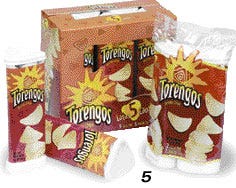 like triangles to make them easy to dip, so why not package them in a triangular canister? Anticipating new canister shapes to come, Cincinnati-based P&G did just that, to uniquely display the chips. Together with Consolidated Container Company, LLC, MRI Flexible Packaging, Fleming Packaging and fp Spiralkote, P&G developed an exciting gold award winner in food that could be the first triangular can of its kind on the market. The product was launched nationally in December, '01 (also see PD, January, '02, p. 10).
like triangles to make them easy to dip, so why not package them in a triangular canister? Anticipating new canister shapes to come, Cincinnati-based P&G did just that, to uniquely display the chips. Together with Consolidated Container Company, LLC, MRI Flexible Packaging, Fleming Packaging and fp Spiralkote, P&G developed an exciting gold award winner in food that could be the first triangular can of its kind on the market. The product was launched nationally in December, '01 (also see PD, January, '02, p. 10).
Extrusion/blow-molded by Consolidated on what P&G describes as a state-of-the-art continuous-extrusion, blow-molding machine with large-cavity molds, the high-density PE-based, multilayer canister has a low-level EVOH oxygen barrier layer that enhances chip taste during storage and provides superior product protection.
Holding 5.6 oz of stacked tortilla chips, the canister design borrows concepts from P&G's Pringles packages and is topped with a heat-sealed foil membrane from Fleming Packaging/fp Spiralkote and an opaque white, snap-fitting, reclosable overcap.
Thermoformed by Ivex of PET, the white overcap is handsomely embossed with a spiraling triangle motif replicated in the label graphics. Brand identity and graphics are carried on the can's clear-film stretch-sleeve label, flexo-printed in festive, warm tones. The full-body stretch sleeve features an orange, lime-green and magenta color scheme, spiked with a contemporary sunburst/spiral repeating background pattern that suggests the tortilla chips' heritage.
Torengos' graphics, brand identity and package design were created in conjunction with LPK (Libby Perszyk Kathman) to compete for market share alongside conventional bagged chips. Since stacked tortilla chips are new to the marketplace, package graphics were created to leverage shelf impact.
MRI Flexible reverse-flexo-prints the clear, monolayer LDPE stretch-film label using digitally made flexo plates, direct-to-plate, in eight colors, including six process colors and two special colors (burnt orange and lime green).
MRI says the flexo plates give the sleeve vignettes a cleaner, sharper image. Tight tolerances with regard to label seam location and print height were factored into the printing of the label, PD is told. Application of the sleeve is done using customized, 10-head rotary sleeve applicators. Filling is performed at a plant in Jackson, TN, on proprietary equipment, P&G's packaging engineer Gerard Buisson tells PD.
A first in salted snacks, and reportedly P&G's biggest packaging effort since the Pringles can, the inventive triangular container follows the profile of the curved, white-corn chips inside, to keep them whole and unbroken. To keep the chips fresh and to improve shelf life, the can includes an oxygen barrier and is flushed with nitrogen.
"Sales from the trade have been very good from the beginning," Buisson reports. "Consumer acceptance is very favorable. Consumers see the package as unique for its shape, for maintaining chip freshness and whole chips, and for being portable and easy to handle. Part of the complexity here was melding these consumer needs with our manufacturing systems. This could not have been accomplished without the high-quality teamwork of everyone involved." Circle No. 331.
Carrots hop into slider pouch
Three gold winners in food were selected this year for noteworthy slider zipper closure systems. The first is Eldorado Farms' redesigned bag for Market Prize peeled carrots (6). 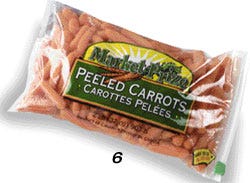 The new bag has several consumer-friendly, value-added convenience features that are driving sales. Converted by Pliant with a Relliant Series 200 sliding zipper closure over an inner-gusseted liner that's perforated for first-use opening, the 2-lb bag won a gold award for its user-friendly attributes. The successful bag, which marks the debut of the Relliant closure, leapt into supermarkets in Western Canadian provinces in September, '01 (also see PD, March, '02, p. 32).
The new bag has several consumer-friendly, value-added convenience features that are driving sales. Converted by Pliant with a Relliant Series 200 sliding zipper closure over an inner-gusseted liner that's perforated for first-use opening, the 2-lb bag won a gold award for its user-friendly attributes. The successful bag, which marks the debut of the Relliant closure, leapt into supermarkets in Western Canadian provinces in September, '01 (also see PD, March, '02, p. 32).
Replacing a conventionally sealed, PE pillow-pack bag with no reclosure, the gusset-topped structure is made tamper-evident with a large green clip-tab, molded with an arrow pointing in the direction of the opening.
Since PD last covered the package, Eldorado, a Redcliff, Alberta, grower, says little has changed with the Market Prize bag for peeled carrots, which is still leaving competitors out in the grass, it says. Pliant's in-house art department in Macedon, NY, contributed the custom design of the package structure. It's made of 100-percent-recycled PE, punched with macroscopic holes to extend the shelf life of the carrots by allowing them to respire once packed. Pliant produces the 2-mil, monolayer blown LDPE/ethylene vinyl acetate-blend film at its plant in Langley, BC, where the bagstock is surface-printed in six colors on an eight-color Paper Converting Machine Co. flexo press.
Rolls of the bag material are converted at Pliant's facility in Shelbyville, IN, where they're made into bags and the zipper is applied, on Amplas MS 1400S side-welding equipment. A wide opening also affords easy access to the carrots. Circle No. 332.
Slider pack seals success for Sargento
The two other gold winners are both for shredded cheese. One, for Sargento Foods' shredded cheese, is described by Curwood as the first commercially available, hermetically sealed, gas-flushed shredded cheese pack equipped with a slider zipper closure (7). 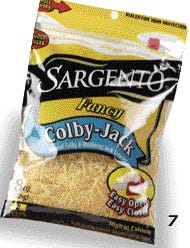 The flexible film pouch, which features Curwood's IntegraScore® opening feature and Pactiv's Hefty® Slide-Rite® slider zipper closure, went into distribution in November, '00 to great acclaim (see PD, March, '02, p. 32 and December, '00, p. 4).
The flexible film pouch, which features Curwood's IntegraScore® opening feature and Pactiv's Hefty® Slide-Rite® slider zipper closure, went into distribution in November, '00 to great acclaim (see PD, March, '02, p. 32 and December, '00, p. 4).
The pack, which is made of a film incorporating 60-ga biaxially oriented nylon/50-ga PE/1.75-mil modified EVOH and LLDPE coex, is supplied to Sargento in rollform. Graphics are reverse-printed by flexo in eight colors. The pack encloses the Slide-Rite slider zipper beneath a perforated "hood" and hermetic seal. Once a tearstrip on the top of the pouch is removed, the slider is then exposed and can be moved along the zipper track to an open position, providing access to contents.
The consumer removes a portion of the top of the package to expose the slider, and thus gain access to the cheese. This tamper-evident structure is now used for more than 40 cheese products marketed by Plymouth, WI-based Sargento, including 8-, 12- and 16-oz retail-size shredded and 8- and 16-oz snack-cube sizes.
The Hefty Slide-Rite zipper replaces a press-to-close zipper on the packaging. Critical to the package's tamper-evidence is film converter Curwood's IntegraScore technology, which completely enshrouds the zipper and keeps it hermetically sealed.
Sargento's senior packaging engineer, Judy Fisher, explains that her company required that the seal be completely tamper-evident and the opening feature be hermetically sealed. The slider zipper in a hood of film can be cleanly detached from the pouch along a precise score line upon opening. Exactly how this score is added to the film remains a mystery perhaps known only to Curwood, but PD learns that it is incorporated into the film before it is sent to Sargento for package making. Sargento receives the film with the score lines already added.
Regardless, it's a critical feature to the functionality of the package, notes Fischer. She says that to be completely hermetic, the cheese pack had to have more than just a closed zipper; it had to be completely airtight. "The technology that Curwood brought forward allowed us to use a hood design to enclose the opening feature, but also gives the package a clean, consistent opening device," Fischer points out. "It is consistent and works well. We've had great success with this package."
Fischer says the package design was a challenge, because at the time, reclosable slider zipper technology was in its infancy. "When we began working on this, there was no technology to be able to use Pactiv's wonderful closure within a hermetically sealed package. There was little if any technology to do what we wanted. Sliders were only being used on food-storage bags then."
Sargento packages the products in Plymouth on hf/f/s equipment outfitted for gas flushing. The plant applies the Slide-Rite zipper in-line on at least one modified production line, using a retrofitted closure-application system from Pactiv. Fisher says, "We needed to manufacture and assemble all components in-line."
She adds that consumers will have to wait and see whether Sargento will apply the technology to additional cheese packaging. The company says it has a patent on the package, and patents are pending regarding the package design and construction. "We worked with Pactiv for eighteen months to develop and manufacture a slider that would work in a hermetically sealed package," Fischer says. "And there were only a few parts of the package that made it a difficult project to complete. But it was well worth it, and it was exciting to see it come together at the end." Circle No. 333.
Krafty slider, scoring for cheese
The third such winner, for Kraft's shredded cheese (8), also features a hermetically sealed and enclosed slider zipper for tamper-evidence and also replaces conventional cheese packaging. But Kraft's 8-oz bag of shredded cheeses features the Slider Zip zipper system, provided through Pechiney Plastic Packaging. The gold award winner in food incorporates Zip-Pak USA's Slider™ clip closure, representing one of the first applications of the Zip-Pak Slider clip being applied in-line.
Applied on a Pacmac system, the slider zipper, in this case, is enshrouded in the package's header and can be accessed by a laser-scored tear-notch at the top of the bag that can be easily removed before use. The scoring allows the hood to give way and reveal the slider closure.
Bagstock from Pechiney is a PET/LDPE/EVOH coex lamination that, combined with the slider zipper, runs efficiently on Pacmac's slider-ready vf/f/s equipment, outfitted for gas flushing. PD is told that the bagstock is now also running on f/f/s equipment from Bossar. The machines apply the slider clip system to the prescored filmstock. Confirms Kraft, the product is being packaged in two locations: one in Medford, WI, and the other in Springfield, MO.
A small teardrop-shaped hole-punch opening on both sides of the C-fold in the pack encircles the red slider tab to allow easy access to the slider, but prevents the slider tab from moving back and forth. Once the header has been removed and the zipper is opened, a peel seal in the zipper flange providing a hermetic seal is revealed. After the filmstock leaves Pechiney's hands, the punch-out hole is inserted, in-line, during bagforming, before the cheese is filled.
Pechiney laser-scores the film using a special technology that allows the film to tear cleanly and consistently, with every pack. "The depth of the laser score into the film was optimized for flawless opening without risk of premature stress cracking on the line of weakness," Pechiney stated when the package won an FPA award in March (again, see PD, March, '02, p. 32). "The film also is designed to allow efficient scoring as well as controlled tensile failure that provides the consistent package opening," Pechiney added.
Currently, says Northfield, IL-based Kraft Foods' senior manager of communications, Kris Charles, there are two skus that include the slider zipper: the 8-oz bag of Finely Shredded Sharp Cheddar and the 8-oz Finely Shredded Colby Jack. "The Slider Zipper will be incorporated on additional [cheese] shreds skus moving forward," she says, adding that the package meets the needs of consumers who require easier resealability. "Consumers ask for and expect Kraft to bring them innovation, whether it is new products, forms, flavors, recipes or packaging," she says. "The Slider Zipper represents one of many ways Kraft Cheese is responding to the needs of our consumers, and they have responded very positively throughout its development."
Pechiney's director of communications, Mark Lindley, notes that consumers of shredded cheeses have come to depend upon packages that are easy to open and can be resealed to ensure longer-term freshness. Circle No. 334.
Shipper keeps its cool for days
Valuable medical, pharmaceutical and chemical products can be practically worthless if not shipped properly. But now, a container with a five-day duration provides vast opportunities for reduced shipping costs, secure shipments and reduced product loss (9). 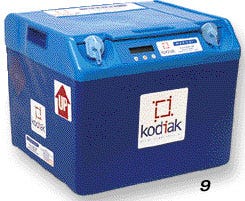 Winning a gold award in the nonfood category, Kodiak Technologies' patented Cold Chain shipping container ensures self-contained temperature control for up to five days without the use of an external power source to operate, as is needed by a storage system such as a refrigerator. Able to be rented by the customer, the reusable, patented, vacuum-insulated-panel container is suitable for keeping pharmaceuticals and biological products cold throughout the shipping cycle and keeps tabs on their status through a logistics service. The container comes in models that actively control a choice of cold temperature ranges.
Winning a gold award in the nonfood category, Kodiak Technologies' patented Cold Chain shipping container ensures self-contained temperature control for up to five days without the use of an external power source to operate, as is needed by a storage system such as a refrigerator. Able to be rented by the customer, the reusable, patented, vacuum-insulated-panel container is suitable for keeping pharmaceuticals and biological products cold throughout the shipping cycle and keeps tabs on their status through a logistics service. The container comes in models that actively control a choice of cold temperature ranges.
The shipper has an outer shell blow-molded of HDPE and a thermoformed inner shell of high impact polystyrene. The latch-lock lid and upper portion of the container body are injection-molded of polycarbonate alloy for strength and toughness. Between the outer and inner shell are at least two 1-in. vacuum-insulated panels that are wrapped in DuPont™ Mylar® polyester film. The panels are designed to resist gas and water-vapor permeation and provide high thermal-resistance. Foamed-in-place with a unique mixed open/closed-cell polyurethane, the VIPs are made of Dow Chemical's Instill® microcellular, open-celled PS foam and are surrounded by the laminated barrier film structure. The vacuum panels provide an insulation-resistance value (R-value) of 50 (per inch), which compares to a conventional foam cooler with an R-value of roughly 5.
The container's refrigerant, or phase-change material, is located in the lid and is thermally isolated by insulation said to minimize heat transfer between it and the payload volume. "Nothing is put into the container itself to change or regulate the temperature. The product goes in, the lid goes on, and the container is ready to be shipped," Jay Zinser, president of Houston-based Kodiak, tells PD. "This uses no dry ice, which can be difficult to handle or can interact with a product. For frozen applications, we use a certain type of phase-change material that can eliminate problems associated with dry ice."
Incorporating what Zinser calls continuous temperature monitoring and active temperature control technology that regulates cold temperatures during transport, the container provides readily available temperature results, without the use of dry ice, carbon dioxide refrigerants or gel packs. Instead, it uses phase-change materials that allow a shipment to withstand external environments below zero without freezing the product.
This is helpful even when a destination is only a day or two away, as the container could prevent product loss when unexpected problems occur in the cold chain, says Zinser. "We are talking with one client that ships knee implants and heart valves."
Kodiak has integrated the system with a logistics provider and a website-based information system to serve as a single source for customer logistics and Quality Assurance management. The temperature information available for verification, such as current temperature, external and internal temperature, and average temperature, can be retrieved three ways: via a liquid crystal display (LCD) screen on the shipper, through an upload port on the container or through logistics and web-based information provided through a secured, online Internet account.
"This way, the shipper indicates the temperature at which the product was contained, and for how long, providing immediate verification that the product arrived within certain temperature specifications," Zinser explains.
After the lid is removed, placed in the freezer and frozen, the container is ready to use. A thermal control regulator senses the temperature within the container. This thermal conduit or valve between the refrigerant and payload volume engages the phase-change material in the lid to an aluminum cold plate that sits on the underside of the lid and removes the heat from the container. As the temperature within the shipper drops, the valve, what Kodiak describes as a self-sensing, temperature-sensitive, paraffin-based thermal actuator that freezes and thaws at a selected temperature, disengages the phase-change material from the lid and maintains the temperature within the specified range. The freezing/thawing effect expands or contracts the paraffin, resulting in a displacement of the actuator. This displacement makes or breaks a thermal path located between the refrigerant in the lid and the payload compartment.
For security purposes, a data-logging system tracks when the lid is opened and closed during shipment, removing any guesswork as to whether or not the cold chain may have been broken in transit.
In development for about a year and a half, the container was designed for use with perishable items such as biologicals, vaccines, chemicals, specialty foods and other temperature-sensitive products. Kodiak, which became the exclusive manufacturer of thermoelectric cooling assemblies for the Igloo Products' actively cooled consumer products in '99, says numerous attempts have been made to develop active shipping containers using thermoelectric technology, vapor compression and adsorption/absorption systems. But most, Zinser says, require power, even with vacuum insulation, and often cannot maintain temperature for long periods of time.
Three shipping container capacities are available, with internal volumes of 4, 22 and 37 L. Customers order the containers, load them when they arrive, press three buttons on the outside to initiate the temperature log and then can track and monitor the shipments and obtain temperature reports through Kodiak's website. Kodiak, in turn, retrieves the empty containers, uploads temperature information from that group of containers, posts it on the website for the customer and inspects and cleans the empty containers.
The Cold Chain shipper was commercialized last summer. Dow Corning began to work with the Cold Chain container in April, '01 and started shipping silicone adhesives in April, '02 from Auburn, MI, to a customer in Costa Rica for use in the manufacture of high-speed computer chips. Says Dow Corning's Sherrie Wegener, "The system works well for us. It has streamlined the shipping process for refrigerated products and reduced the cost of recycling the materials we used previously. Before the Kodiak shipper, we packed insulated shippers with blue ice, but those materials would all eventually be discarded, and most weren't able to be reused. Kodiak containers are reusable, and they can be cleaned and inspected, so it makes things easier for us."
Zinser also says Baxter Healthcare is using the container domestically for shipments of clinical trial drug products, and NASA has also tested shipments in the retrieval of mineral samples from the Yukon. Circle No. 335.
Sit up and bag
A side-gusseted, standup bag that enhances the display of pet food won a silver award in food for Bischof+Klein, Germany and U.S., and Germany's Reinhold Maschinen-und Geratebau GmbH. While it sounds rugged, the U-Pack™ (which stands for Universal Package), a premade, side-gusseted plastic film pouch (10), 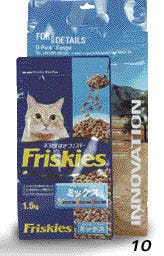 provides five panels, or 360 deg of graphic fanfare and standup storage with its flat, square bottom. To make it consumer-friendly, the space-saving, cube-efficient package is available with an easy-open tear-notch, a reclosable zipper, a punched slot for pegboarding, a bottom strip, a carry handle and an independent pour spout. The U-Pack is currently marketed in Japan by Nestlé for Purina Friskies pet food.
provides five panels, or 360 deg of graphic fanfare and standup storage with its flat, square bottom. To make it consumer-friendly, the space-saving, cube-efficient package is available with an easy-open tear-notch, a reclosable zipper, a punched slot for pegboarding, a bottom strip, a carry handle and an independent pour spout. The U-Pack is currently marketed in Japan by Nestlé for Purina Friskies pet food.
Bischof+Klein can produce the package in several sizes using various bagstock combinations, depending on customer needs. Adhesive-laminated material combinations can include polyester, PP, PE, polyamide, EVOH and EVA copolymers, with other combinations such as metallized and aluminum compounds.
One example called the Standup/Standout pouch includes a 5-mil, seven-color reverse-gravure-printed adhesive laminate of 48-ga PET/48-ga PET/4 mil PE. The pouch measures 10 x 51/2 x 191/2 in., and can hold about 10 lb of product.
Introduced in March to the North American market and used widely in Europe and Asia, the U-Pack serves as an alternative to traditional paper pinch-bottom/open-mouth sacks and standup pouches. And, since it's available in several sizes, it can be used to display different quantities of product, yet maintain a consistent look on-shelf. In addition, because it's seamless, it can be printed with wraparound graphics on all panels.
In September, '01, Nestlé Japan began marketing its own version of the U-Pack bag with 20-deg side gussets, a reclosable zipper, rounded corners and an easy-open tear-notch in 500-g, 1-kg and 1.5-kg sizes for Purina dry pet food. The pouch consists of a three-layer structure with a fin-seamed bottom, an easy-open feature and a reclosable zipper. Made into bags on equipment from Reinhold Maschinen-und Geratebau in the cross direction, according to Bischof+Klein Germany's Bodo Moehlmeyer, the structure is a 12-micron polyester/12-micron metallized polyester/90-micron LLDPE sealant layer. The films were chosen for shelf life, product stability and freshness. The metallized polyester improves oxygen and moisture barriers. The bags are printed by gravure in eight colors. After it makes the Nestlé packages, Bischof+Klein ships them to Nestlé Purina's pet food production facilities in Blayney, Australia, for filling and sealing.
The filled bags are then sent to Japan, where they're distributed nationally. Bischof+Klein's Charles Stanland in the U.S. reports that the pouch can be made in either the cross direction or the machine direction, depending on the package, and the bottom strip application is made in the cross direction.
Bischof+Klein currently has four Reinhold machines in its facility in Lengerich, Westphalia, Germany.
Stanland also points out that the Nestlé pouches do not incorporate Reinhold's patented bottom strip technology that gives most U-Pack structures their flat, square bottom that allows them to stand up. "It's a unique feature that other bags don't have," he says.
Available in sizes ranging from 1.10 to 35 lb, the U-Pack can be customized with a number of options to provide improvements in production, warehousing and shipping, because it can maximize cube space with its flat bottom. It also squares up after it is filled. Stanland says the cube efficiency allows users to increase the number of pouches that can be packed into a shipper, or it can eliminate secondary corrugated shippers altogether. In development for about three years, the package is suitable for coffee, lawncare products, fertilizer and pesticides, dry granular products and assorted liquids.
"U-Pack is poised to become the next generation of new packaging technology," says Stanland. "We expect demand for this pouch to continue to increase as pouch production increases. We're selling the pouch in Europe and Asia and hope to have a consumer application for the package in the U.S. soon." Circle No. 336.
Bacon beckons in a pouch
Kraft Foods' Oscar Mayer Div. has shifted from metal cans for its Bacon Bits to a convenient, standup pouch with a window that holds 3 oz of Real Bacon Bits or Recipe Pieces (larger bits) in a 2.8-oz pouch (11).  Winning a silver in food, the palm-sized gusset-bottomed pouch offers freshness, visibility, storage and reclosability to the ready-to-serve bacon bits.
Winning a silver in food, the palm-sized gusset-bottomed pouch offers freshness, visibility, storage and reclosability to the ready-to-serve bacon bits.
Measuring about 6 in. tall and 4.5 in. wide, the package has an oxygen-scavenger packet inside that helps keep the bacon bits fresh. Shelf life is at least five months, as indicated by the code date on a pouch PD purchased.
Curwood provides the proprietary, multilayer film pouch, which is preprinted with a window so that the consumer can see the actual bacon bits, with the Integra-Score easy-opening feature. Zip-Pak USA furnishes a press-to-close zipper for reclosability convenience. The pouch is also 30-percent lighter than traditional rigid packages such as cans or glass jars. Launched nationally in October, '01, the product sells for $1.49.
The two products are doing well in the market, says Sarah Delea, senior communications manager of Kraft Foods North America. "Both products are growing in terms of sales and distribution with the introduction of the new package. It has been doing very well and gives the bacon bits more shelf presence due to its size. It also lets consumers see the product while it's displayed, and because it stands up or can be pegged, it offers retailers different display options."
The new pouch has a wide opening that allows the product to be shaken or poured out, or spooned onto soups, potatoes, nachos or many other foods.
Die-cut at the top with a peg hole that adds a retail merchandising option on meat pegs or clip strips, the pack replaces similarly sized metal cans. "The standup pouch is a design innovation that provides a contemporary new look," Kraft Oscar Mayer states. "It's an easy-to-use package that is lighter in weight than the previous metal can. The packaging material and processes are more cost-efficient. This is a new application of existing technology developed by Kraft R&D that provides an easy-to-use and open package."
Delea says that she cannot provide much more information on pouch material specifics, suppliers, how or where the product is packaged or other equipment details. Circle No. 337.
PB&J slices
Also among the food-category silver winners is Schreiber Foods and Printpack for what could be the hottest invention since sliced bread: individually wrapped slices of peanut butter and jelly (12). 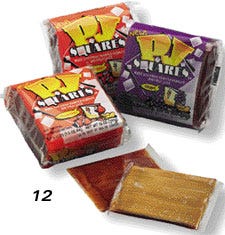 To make sandwich preparation a breeze for kids and parents alike, PJ Squares contains 10 slices of PB&J in a 12-oz outer wrap. The product is available in peanut butter and grape jelly and peanut butter and strawberry jelly.
To make sandwich preparation a breeze for kids and parents alike, PJ Squares contains 10 slices of PB&J in a 12-oz outer wrap. The product is available in peanut butter and grape jelly and peanut butter and strawberry jelly.
The slices are individually wrapped in Printpack's barrier, cast-coextruded, 1.5-mil PP film with a release agent. Ten wrapped slices are overwrapped in a Vifan CL 1.38-mil, two-side-sealable coextruded BOPP from the Vifan Films Div. of the Vibac Group. Reverse-printing on the outer wrap is by flexo in six colors. The refrigerated product has a six- month shelf life.
The combination of films allows children to be able to make their own sandwiches without opening and closing any jars, and weighs less and takes up less volume than jars, says Schreiber. Often used for slices of processed cheese and meats, the new format is both convenient and kid-friendly.
First test-marketed as a refrigerated product beginning in April, '01 in Indianapolis, St. Louis, Chicago and Grand Rapids, PJ Squares has met with a positive sales response. Schreiber's principal engineer, Dan Shannon, says repeat orders have exceeded expectations. As of presstime, the product is being reformulated to be shelf-stable, unrefrigerated, for up to one year. The package is also undergoing some revisions, Schreiber's Deborah Van Dyck tells PD.
Reports Shannon, "Because the product is packaged in a barrier film in individual servings, it's not exposed to oxygen until its used. This is not the case with conventional jars of peanut butter or jelly. Once the jars are opened, the remaining product is exposed, which over time, will cause the peanut oil to oxidize and the jelly to discolor and lose flavor." A multilayer filling and packaging system new to the food industry, like the barrier film wrap, took many months to develop. Patent applications have been filed with the U.S. Patent Office, Shannon says.
Other products that could be packaged using variations of this technology include peanut butter and marshmallow, slices of different types of processed cheese, or combinations of processed luncheon meats.
Van Dyck points out that PJ Squares is not the successor of a similarly sliced peanut butter product developed by researchers at Oklahoma State University in '00 (see PD, September, '00, p.4). That product was produced and film-wrapped on conventional cheese-slice-forming and overwrapping equipment. But at the time, PD asked if jelly would be next, and sure enough, it was. Circle No. 338.
Portable sipper soups it up
For those in a hurry, and that seems to be everyone at some point in the day, ultra-convenient meals are a top priority. With that in mind, Campbell Soup Co., Camden, NJ, has created one of the biggest packaging developments to hit the soup section in years. Campbell's® Soup at Hand™ sippable, portable soup-in-a-cup (13) 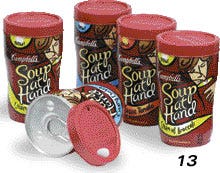 fits neatly into a car's cupholder. And that's probably by design. With so many people on the move today, Campbell's felt the need to offer a functional package to make soup a choice for sipping or drinking "on the go." No spoon or other utensil is required.
fits neatly into a car's cupholder. And that's probably by design. With so many people on the move today, Campbell's felt the need to offer a functional package to make soup a choice for sipping or drinking "on the go." No spoon or other utensil is required.
Another silver winner in food, the 103/4-oz cup allows soup lovers to eat with one hand and drive with the other. Portable, on-the-go meals aren't exactly new, but eating in the car has become as common as a cell phone, so a hand-held container that's spill-resistant, microwavable and shelf-stable is a welcome mouthful.
Test-marketed in September, '01 in Pittsfield, MA, and EauClaire, WI, the convenient Soup at Hand cup was officially introduced at the Food Marketing Institute show in Chicago in May (see PD, June, '02, p. 4).
The multilayer barrier plastic cup is molded of an opaque-white plastic and covered with a double-seamed aluminum end with a metal pull ring, and a bright red overcap with a large opening for sipping that's ample enough for big chunks of chicken or vegetables to pass through. Attracting attention is a vivid, four-color, flexo-printed, coextruded oriented PS foam wraparound label, believed to be from American Fuji Seal, that provides insulation to keep the product hot while the outside of the package is comfortable to the touch.
Standing 4.5 in. tall when capped, and approximately 70mm in dia at the top, uncapped, the Soup at Hand container is somewhat reminiscent of Campbell's earlier introduction, Soup To Go microwavable soup-in-a-bowl package. Soup To Go's bowl was coinjection-molded with HDPE, PP and a barrier layer of EVOH, and is molded with the recycling symbol for HDPE.
The taller Soup at Hand container also features the HDPE recycling symbol. The Soup at Hand package is retorted, Campbell's Jeff Bedard confirms, but that's all he can say about the process. The Soup at Hand container is produced by Silgan Plastic Containers and is filled at Campbell's plant in Marshall, MI.
Red, orange and black label graphics match the color of the lid, which is embossed with the Campbell's logo, instructions to remove the overcap before microwaving and the admonition, "careful–contents hot." The metal end and overcap are removed before microwaving, and the red overcap is replaced on the heated container after microwaving on high for more than one minute.
An update since PD's news article from Campbell's John Faulkner, director of corporate and brand communications, indicates that no structural changes have been made to the package, and the product is being well received by the trade. "Market acceptance has been very good in both of the test markets, and we project that it will be a sizable business for Campbell Soup Company." The new soup will go national in September.
Shelf life is at least six months. Priced at $1.49, the line includes Classic Tomato, Creamy Chicken, Cream of Broccoli, and Blended Vegetable Medley. Classic Tomato and Creamy Chicken will also be sold in four-packs.
Faulkner points out that Soup at Hand isn't just for commuters but for anyone who wants super-convenience. "The innovation makes soup a choice for people when they are on the move and it's inconvenient or impossible to use a spoon." Circle No. 339.
Carry-outs biodegrade
PD has covered many of EarthShell Corp.'s recent developments in disposable, biodegradable, compostable foodservice containers, both in print and online (see News Perspective, October, '00, p. 14 and February, '01, p. 84, for example). The patented EarthShell® Packaging technology (14) 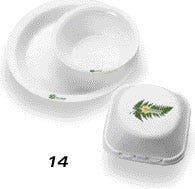 allows the combination of ingredients such as limestone and starch, including DuPont's Biomax® biodegradable polyester resin and other biodegradable materials, to be used to produce plates, bowls and hinged-lid containers such as the clamshells used for the Big Mac sandwich, which McDonald's restaurants trialed two years ago in the Chicagoland area.
allows the combination of ingredients such as limestone and starch, including DuPont's Biomax® biodegradable polyester resin and other biodegradable materials, to be used to produce plates, bowls and hinged-lid containers such as the clamshells used for the Big Mac sandwich, which McDonald's restaurants trialed two years ago in the Chicagoland area.
Now it's being made into foodservice sandwich wraps.
The silver winner in food comes in various package forms that may be printed using either a dry offset process or with soy-based inks. The ingredients include ground limestone, starch from potatoes, titanium dioxide and biodegradable polymers (other starches and inorganic materials may be used). Rollstock of the flexible wrap is then printed, cut into sheets and cased for shipment.
Said to be 100-percent biodegradable, cost-competitive and recyclable through composting, the foodservice containers keep foods hot and resist leaking. While the technology is initially being used in the foodservice arena, it can easily be extended to other consumer disposable products.
EarthShell says it has been working with several quick-service restaurant chains in the development of the foodservice sandwich wrap, which went into test markets in February in the Baltimore area. Several area companies have purchased initial quantities. The patented wrap material has been designed with the environment in mind for uses such as disposable packaging for hot and cold sandwiches such as hamburgers, breakfast sandwiches, subs, tacos and side orders.
EarthShell's John Nevling, director of product management and environmental affairs in Lutherville, MD, says the initial feedback from the quick-service chains has been positive. "A number are in various stages of considering the product for use in their systems. Foodservice disposable packaging is only the first application for this technology. We believe it can be adapted for use in other applications."
Designed as an alternative to foil, paper and plastic-laminated sandwich wraps, the material should be able to be produced using existing converting equipment, the co. reports.
EarthShell has formed a number of joint-venture agreements over the years with foodservice distributors, converters and packaging suppliers. In July, the company announced it formed an agreement with DuPont to combine its composite material technology with DuPont's expertise in materials, development, manufacturing and marketing. Last April, DuPont also formed a joint-development alliance with EarthShell to identify opportunities that combine EarthShell packaging with DuPont's Biomax hydro/biodegradable technology.
Durable, and grease- and water-resistant, the EarthShell containers are said to use less total energy, according to EarthShell Corp. This can result in lower greenhouse gas emissions than with traditional packaging, and the containers and wraps are also said to be biodegradable in the presence of air and moisture when cracked or broken. Circle No. 340.
More information is available:
Awards program: DuPont Packaging and Industrial Polymers, 302/992-6678. Circle No. 341.
About the Author(s)
You May Also Like


